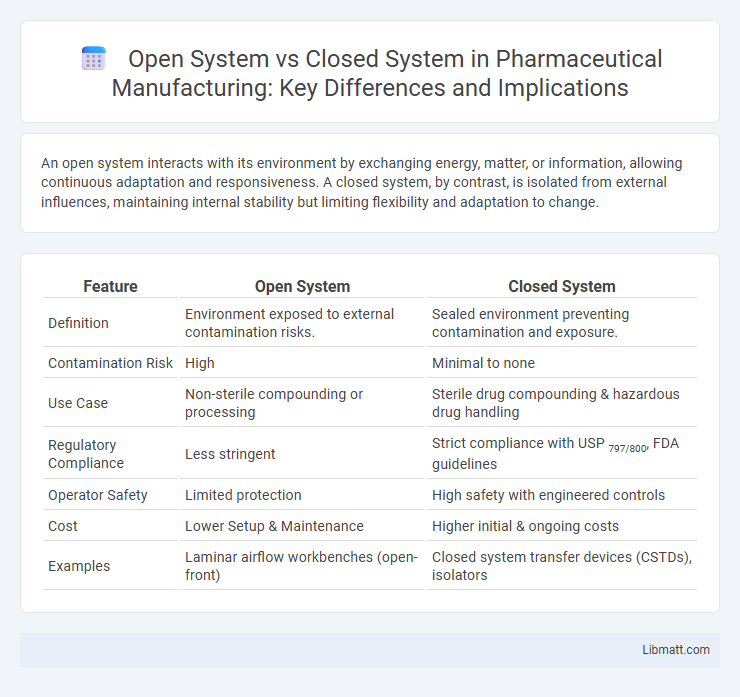An open system interacts with its environment by exchanging energy, matter, or information, allowing continuous adaptation and responsiveness. A closed system, by contrast, is isolated from external influences, maintaining internal stability but limiting flexibility and adaptation to change.
Table of Comparison
| Feature | Open System | Closed System |
|---|---|---|
| Definition | Environment exposed to external contamination risks. | Sealed environment preventing contamination and exposure. |
| Contamination Risk | High | Minimal to none |
| Use Case | Non-sterile compounding or processing | Sterile drug compounding & hazardous drug handling |
| Regulatory Compliance | Less stringent | Strict compliance with USP 797/800, FDA guidelines |
| Operator Safety | Limited protection | High safety with engineered controls |
| Cost | Lower Setup & Maintenance | Higher initial & ongoing costs |
| Examples | Laminar airflow workbenches (open-front) | Closed system transfer devices (CSTDs), isolators |
Definition of Open System
An Open System exchanges matter, energy, or information with its environment, allowing continuous interaction and adaptation. This dynamic flow supports growth, responsiveness, and sustainability in various contexts such as ecosystems, organizations, or thermodynamic processes. Understanding the characteristics of an open system helps you analyze how external factors influence system behavior and efficiency.
Definition of Closed System
A closed system is defined as a physical system that does not exchange matter with its surroundings, although it can transfer energy in the form of heat or work. In thermodynamics, closed systems maintain a fixed amount of matter, making them distinct from open systems, which allow both matter and energy exchange. The concept of closed systems is crucial for analyzing processes where mass conservation within boundaries is essential.
Key Characteristics of Open Systems
Open systems continuously exchange energy, matter, or information with their environment, allowing adaptability and growth in dynamic conditions. They maintain homeostasis through feedback mechanisms, enabling your organization or process to respond effectively to external changes. This interaction with the environment is essential for innovation, learning, and long-term sustainability.
Key Characteristics of Closed Systems
Closed systems are defined by their lack of interaction with external environments, maintaining fixed boundaries that prevent the exchange of matter and energy. These systems prioritize stability and predictability, as internal processes operate in isolation from outside influences, which can limit adaptability. Understanding these key characteristics helps you design processes or models where controlled, steady-state conditions are essential.
Examples of Open Systems
Open systems interact continuously with their environment, exchanging energy, matter, or information. Examples include ecological systems like forests, where organisms depend on sunlight, water, and nutrients from their surroundings, and business organizations that adapt to market changes through feedback and resource flow. Human bodies also represent open systems, maintaining homeostasis by exchanging gases, nutrients, and waste with the external environment.
Examples of Closed Systems
A closed system example includes a sealed terrarium where energy transfer occurs but no matter enters or leaves. Another is a steam radiator, which circulates water within a fixed volume, allowing heat exchange without mass exchange. Thermos flasks also exemplify closed systems by minimizing energy transfer and preventing matter exchange with the environment.
Advantages of Open Systems
Open systems offer significant advantages such as enhanced flexibility, allowing seamless integration with external technologies and easier adaptability to changing environments. Your organization benefits from increased collaboration and innovation opportunities by accessing external resources and sharing data across platforms. This openness also supports scalability, ensuring the system can grow and evolve efficiently with minimal restrictions.
Advantages of Closed Systems
Closed systems offer precise control over environmental variables such as temperature, pressure, and humidity, ensuring consistent and reliable experimental results. They minimize contamination risk by isolating the system from external influences, which is crucial in pharmaceutical manufacturing and chemical synthesis. This containment also enhances safety by preventing hazardous material exposure to the surroundings.
Applications in Real-World Scenarios
Open systems facilitate real-time interaction with the environment, making them ideal for applications like weather forecasting, supply chain management, and social networks, where continuous input and adaptation are critical. Closed systems operate in isolation, providing controlled environments for processes such as industrial manufacturing, laboratory experiments, and certain cybersecurity models aimed at minimizing external influence. Your choice between open and closed systems impacts adaptability, control, and responsiveness in practical scenarios across diverse fields.
Open System vs Closed System: Main Differences
Open systems exchange energy and matter with their surroundings, allowing dynamic interaction and adaptation to environmental changes. Closed systems, in contrast, do not exchange matter with the environment, maintaining internal processes isolated from external influences. Understanding these distinctions helps you analyze system behavior in fields like thermodynamics, ecology, and organizational theory.
Open system vs closed system Infographic

 libmatt.com
libmatt.com